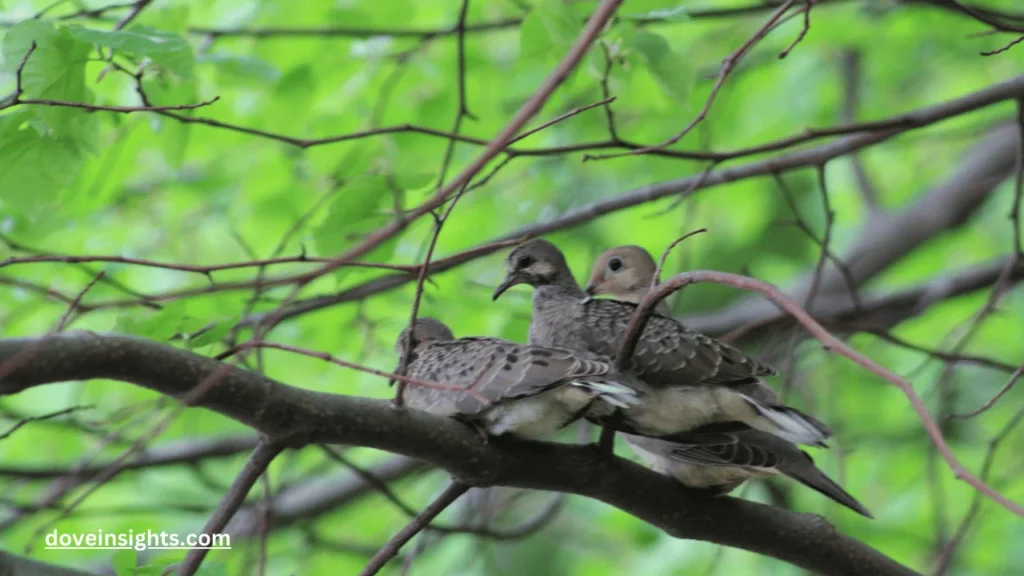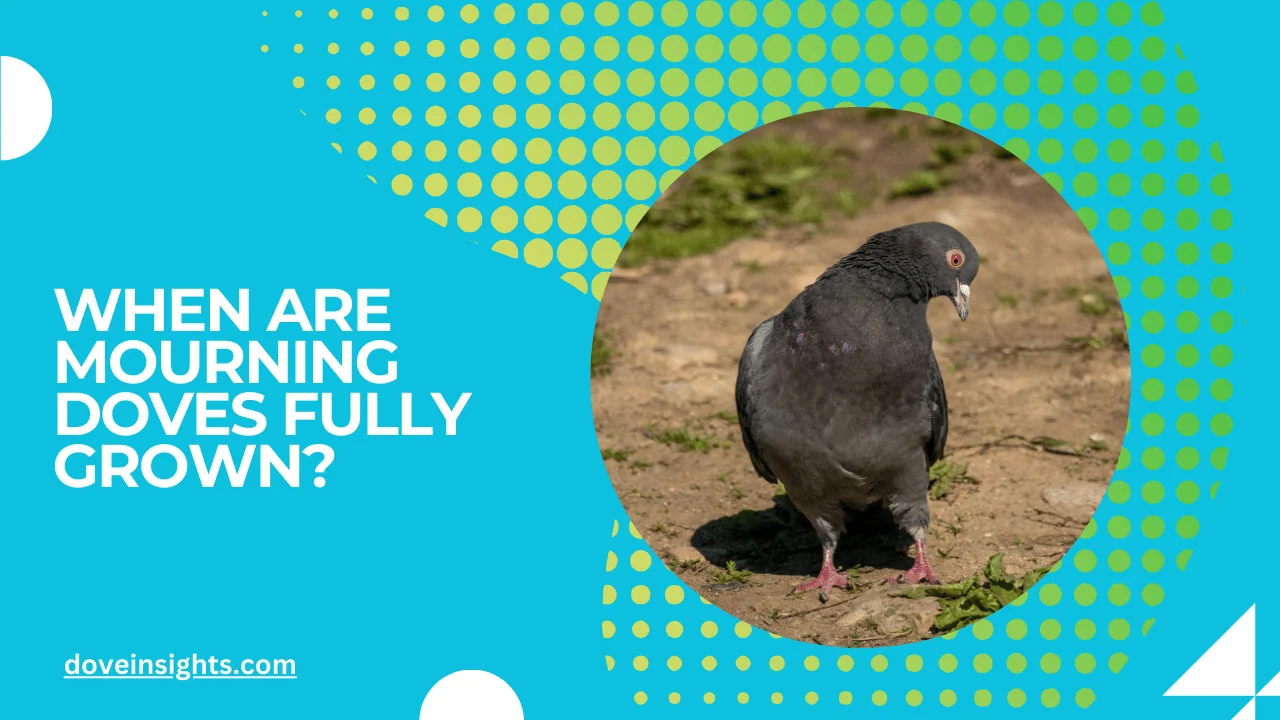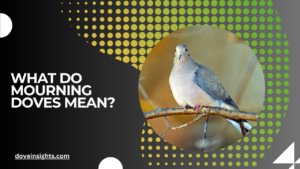Mourning doves are some of the most graceful and recognizable birds in North America, often seen perched on telephone wires or gliding effortlessly through the sky.
Their gentle calls and slender forms have made them iconic symbols of peace and tranquility. But what about their life stages?
When are mourning doves fully grown? Understanding the growth process of mourning doves is more than just a biological curiosity – it’s key to appreciating their role in the environment, their survival tactics, and how they contribute to ecosystems.
In this article, we’ll explore the development of mourning doves from hatchlings to adulthood, how long it takes for them to fully mature, and what factors influence their growth. Let’s dive into the fascinating journey of a mourning dove’s life cycle.
Contents
- 1 The Early Stages of Mourning Dove Development
- 2 The Transition from Nestlings to Fledglings
- 3 Physical Maturation and Developing Adult Features
- 4 Full Growth and Sexual Maturity
- 5 Factors That Influence Mourning Dove Growth
- 6 Conclusion:
- 7 FAQ’s
- 7.0.1 How long does it take for a mourning dove to fully grow?
- 7.0.2 What do mourning doves eat as they grow?
- 7.0.3 How do mourning doves learn to fly?
- 7.0.4 At what age do mourning doves become independent?
- 7.0.5 Are mourning doves fully grown at six weeks?
- 7.0.6 What factors affect mourning dove growth?
The Early Stages of Mourning Dove Development
Mourning doves begin their lives as tiny, helpless chicks. After hatching from their eggs, which are usually laid in nests built by both parents, the chicks are blind, featherless, and completely dependent on their parents for warmth and food.
Within the first few days, they are fed a special secretion called “pigeon milk”, produced by both parents. This high-protein substance is essential for the rapid development of the chicks.
During the first week, the chicks will begin to grow their down feathers and their eyes will open. Growth at this stage is rapid, and the chicks will start developing physical characteristics that are more pigeon-like, including their beaks and feet.
As they mature, they gradually transition from a soft, vulnerable state to stronger, more resilient young birds. This early stage of growth sets the foundation for the rest of their development.
The Transition from Nestlings to Fledglings
Around two weeks old, mourning dove chicks begin to transition from nestlings to fledglings. This is a crucial stage in their growth, as they start learning how to fly and become more independent.
Feathers start to grow in earnest around this time, and the chicks’ bodies begin to take on the familiar shape of adult doves. They no longer rely on the constant feeding from their parents, but they still return to the nest to seek warmth and rest.
As fledglings, mourning doves practice short flights and wing exercises that strengthen their muscles.
They start to explore their immediate environment, although they are still somewhat clumsy and rely heavily on their parents for safety and guidance. During this phase, their diet starts to shift from pigeon milk to solid seeds, grasses, and small plants, which provide them with the energy they need to continue growing.
Physical Maturation and Developing Adult Features
By the time a mourning dove reaches four to six weeks of age, they are well on their way to becoming fully fledged, though they are still not considered fully grown.
The body’s feathers will be more developed, and they will have started to show the distinctive coloration that sets mourning doves apart from other bird species, such as the soft gray or brown hues and the characteristic black crescent on the side of the neck.
Mourning doves at this stage are more independent but may still rely on their parents for occasional feeding and protection.
They will be learning to forage on their own and will be strengthening their flight skills. Although their size and appearance are close to that of adults, they still have some growth to go before they are considered fully grown in terms of both size and maturity.
Full Growth and Sexual Maturity
A mourning dove reaches full physical growth between six to eight weeks of age. At this point, they are fully capable of flight and foraging independently.
The bird’s body will have reached its adult size, and they will have all the necessary feathers and strength to survive in the wild. However, physical maturity is not the same as sexual maturity, which typically occurs a few months after they reach full growth.
By the time mourning doves are around four to six months old, they are sexually mature and capable of reproducing. The development of adult behaviors, such as territoriality and courtship rituals, will follow.
These behaviors are a sign that the dove is fully matured not only physically but also in terms of its role in the species’ lifecycle.
Factors That Influence Mourning Dove Growth

While mourning doves generally grow at a consistent rate, several factors can influence how quickly or effectively they reach full maturity. Nutrition plays a critical role in ensuring that chicks grow at an optimal pace.
Access to food sources like seeds, grains, and plant matter is essential during the fledgling and juvenile stages. Environmental conditions also play a major role, as extreme weather or habitat destruction can slow down development or even impact survival rates.
Another factor is the presence of predators and competition for resources. Doves that live in areas with high predator activity or less abundant food sources may experience delayed growth or may not survive to full adulthood.
Finally, parental care is crucial in the first few weeks of life. Healthy, attentive parents that provide adequate nutrition and protection can lead to faster, healthier growth for the chicks.
Conclusion:
From a fragile chick to a strong and independent adult, the life journey of a mourning dove is a remarkable process of growth and adaptation.
While mourning doves typically reach full physical maturity by six to eight weeks, the transition to full independence takes longer, as the birds learn to navigate their environment, forage for food, and interact with others of their kind. By understanding the stages of mourning dove growth, we can gain a deeper appreciation for their resilience and role in nature.
Whether you’re a bird enthusiast or simply curious about the development of wildlife, the story of the mourning dove’s maturation is a fascinating glimpse into the life of one of nature’s most graceful creatures.
FAQ’s
How long does it take for a mourning dove to fully grow?
Mourning doves typically reach full physical growth by six to eight weeks of age, but they do not reach sexual maturity until they are about four to six months old.
What do mourning doves eat as they grow?
As chicks, mourning doves are fed pigeon milk by their parents, transitioning to a diet of seeds, grains, and small plants as they grow.
How do mourning doves learn to fly?
Mourning doves start practicing flight when they are around two weeks old. They initially take short flights and gradually build their strength and confidence.
At what age do mourning doves become independent?
Mourning doves become more independent around six weeks of age, when they are fully capable of flying and foraging on their own.
Are mourning doves fully grown at six weeks?
Yes, they are physically fully grown by this age, but they are still learning survival skills and may not be sexually mature until later.
What factors affect mourning dove growth?
Nutrition, environmental conditions, and the presence of predators or competitors can all influence the rate of growth in mourning doves.








